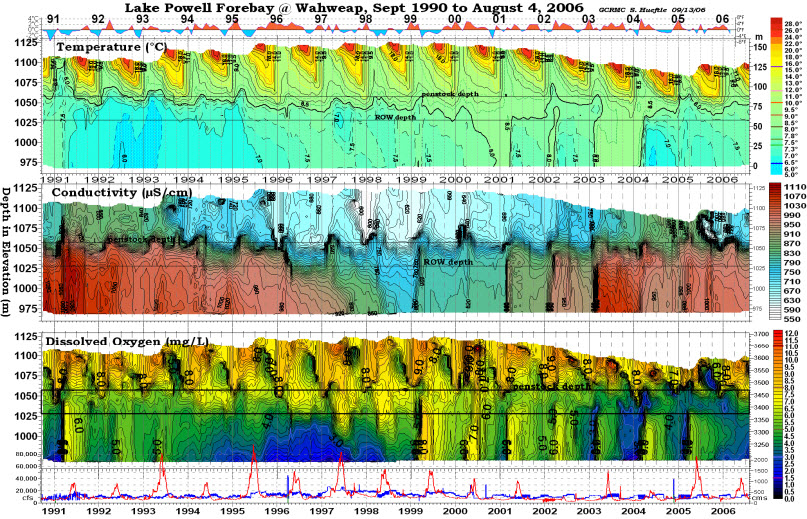Difference between revisions of "WATER QUALITY"
From Glen Canyon Dam AMP
Cellsworth (Talk | contribs) |
Cellsworth (Talk | contribs) |
||
| Line 89: | Line 89: | ||
*[http://www.tandfonline.com/doi/abs/10.1080/07438141.2011.632705 Wildman and Hering. 2011. Potential for release of sediment phosphorus to Lake Powell (Utah and Arizona) due to sediment resuspension during low water level. Lake and Reservoir Management, 27:4, 365-375] | *[http://www.tandfonline.com/doi/abs/10.1080/07438141.2011.632705 Wildman and Hering. 2011. Potential for release of sediment phosphorus to Lake Powell (Utah and Arizona) due to sediment resuspension during low water level. Lake and Reservoir Management, 27:4, 365-375] | ||
'''USGS Data Series, Circulars, and other Reports''' | '''USGS Data Series, Circulars, and other Reports''' | ||
| − | + | *[http://gcdamp.com/images_gcdamp_com/2/26/GCDAMP_FY_2017_Knowledge_Assessment-Science_Advisor_Program_Final_Report_2017-04-30.pdf GCDAMP FY 2017 Knowledge Assessment: Final Report from the Executive Coordinator for the Science Advisors Program] | |
| + | *[https://www.usbr.gov/uc/rm/amp/twg/mtgs/14apr08/TWP_14jun06.pdf?bcsi_scan_cf0ea36431a6106e=xBHF7QVHXt6Zx5nJZ4cG0wktr3sHAAAA6aC3BQ==&bcsi_scan_filename=TWP_14jun06.pdf Glen Canyon Dam Adaptive Management Program Triennial Budget and Work Plan— Fiscal Years 2018–2020] | ||
| + | *[https://pubs.usgs.gov/of/2008/1153/ USGS Workshop on Scientific Aspects of a Long-Term Experimental Plan for Glen Canyon Dam, April 10–11, 2007, Flagstaff, Arizona] | ||
| + | *[[Media:Jones 2001 Final report PEP GCMRC IWQP.pdf| Final report of the Protocol Evaluation Panel for the Grand Canyon Monitoring and Research Center Integrated Water Quality Program (IWQP)]] | ||
| + | *[https://pubs.usgs.gov/ds/471/pdf/ds471.pdf Historical Physical and Chemical Data for Water in Lake Powell and from Glen Canyon Dam Releases, Utah-Arizona, 1964–2013] | ||
| + | *[https://pubs.usgs.gov/circ/1282/ The State of the Colorado River Ecosystem in Grand Canyon: A report of the Grand Canyon Monitoring and Research Center 1991-2004] | ||
| + | *[https://pubs.er.usgs.gov/publication/ds959 Biological Data for Water in Lake Powell and from Glen Canyon Dam Releases, Utah and Arizona, 1990–2009] | ||
| + | '''Water Quality and Glen Canyon Dam Management''' | ||
| + | *[http://onlinelibrary.wiley.com/doi/10.1890/1051-0761(2001)011%5B0644:EFEOTL%5D2.0.CO;2/full Hueftle and Stevens. 2001. Experimental flood effects on the limnology of Lake Powell Reservoir, Southwestern USA. Ecological Applications, 11(3), pp. 644–656] | ||
| + | *[https://pubs.usgs.gov/of/2010/1159/ Effects of the 2008 High-Flow Experiment on Water Quality in Lake Powell and Glen Canyon Dam Releases, Utah-Arizona] | ||
| + | '''Water Quality and Metabolism in the Colorado River below Glen Canyon Dam''' | ||
| + | *[http://azmemory.azlibrary.gov/cdm/ref/collection/statepubs/id/3854 Water quality investigation of seventeen Grand Canyon tributaries: July 2004 - May 2005] | ||
| + | *[https://pubs.er.usgs.gov/publication/70154774 Hall et al. 2015. Turbidity, light, temperature, and hydropeaking control primary productivity in the Colorado River, Grand Canyon. Limnol. Oceanogr. 60, 512–526] | ||
| + | *[http://onlinelibrary.wiley.com/doi/10.1215/21573689-1572535/full Hall et al. 2012. Air–water oxygen exchange in a large whitewater river. Limnology and Oceanography: Fluids and Environments] | ||
| + | *[http://onlinelibrary.wiley.com/doi/10.4319/lo.2004.49.6.1992/full Larned et al. 2004. Mass-transfer–limited nitrogen and phosphorus uptake by stream periphyton: A conceptual model and experimental evidence. Limnol. Oceanogr., 49(6), 1992–2000] | ||
| + | *[https://pubs.er.usgs.gov/publication/70192253 Payn et al. 2017. A coupled metabolic-hydraulic model and calibration scheme for estimating whole-river metabolism during dynamic flow conditions. Limnol. Oceanogr.] | ||
|} | |} | ||
Revision as of 10:31, 31 October 2017
|
|
Desired Future Condition for Water QualityWater quality with regards to dissolved oxygen, nutrient concentrations and cycling, turbidity, temperature, etc., is sufficient to support natural ecosystem functions, visitor safety and visitor experience to the extent feasible and consistent with the life history requirements of focal aquatic species. |
| --- |
--- |
--- |
|---|
